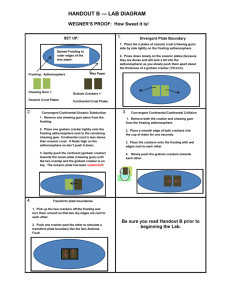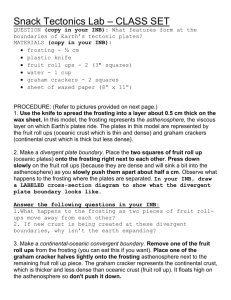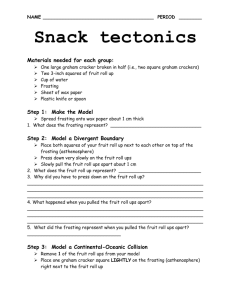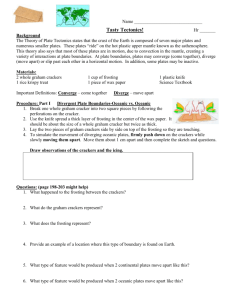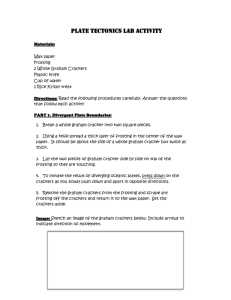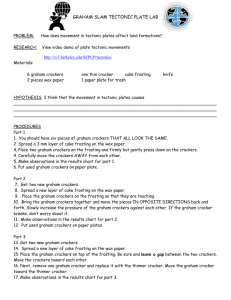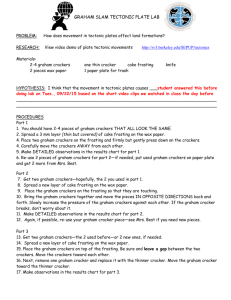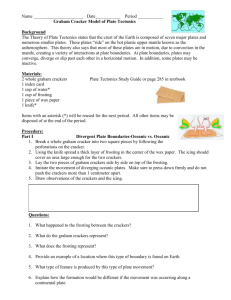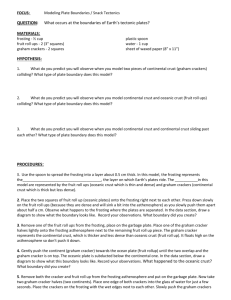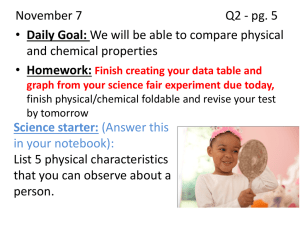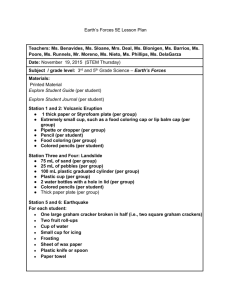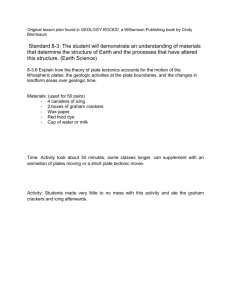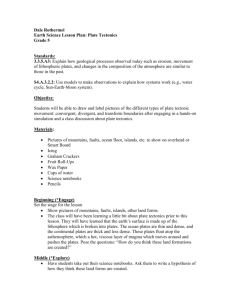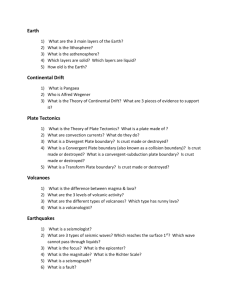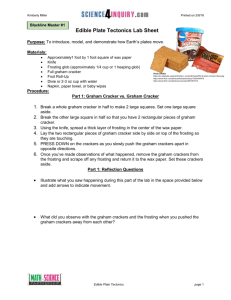Plate Tectonics: Activity/Graham Crackers
advertisement
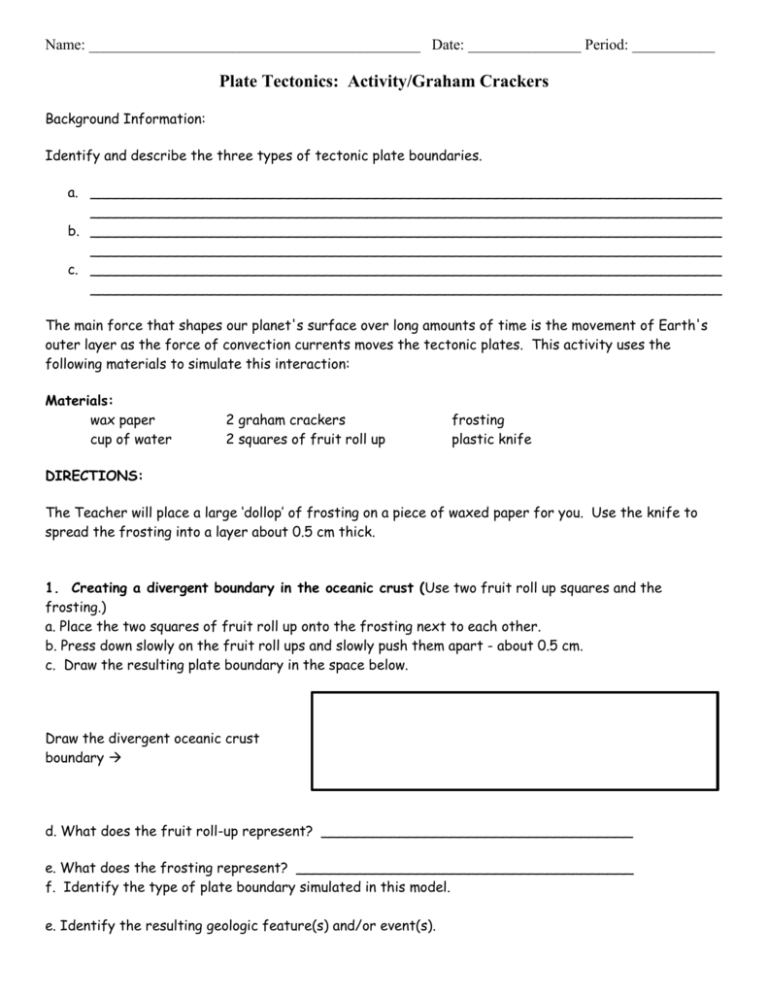
Name: ____________________________________________ Date: _______________ Period: ___________ Plate Tectonics: Activity/Graham Crackers Background Information: Identify and describe the three types of tectonic plate boundaries. a. _________________________________________________________________________ _________________________________________________________________________ b. _________________________________________________________________________ _________________________________________________________________________ c. _________________________________________________________________________ _________________________________________________________________________ The main force that shapes our planet's surface over long amounts of time is the movement of Earth's outer layer as the force of convection currents moves the tectonic plates. This activity uses the following materials to simulate this interaction: Materials: wax paper cup of water 2 graham crackers 2 squares of fruit roll up frosting plastic knife DIRECTIONS: The Teacher will place a large ‘dollop’ of frosting on a piece of waxed paper for you. Use the knife to spread the frosting into a layer about 0.5 cm thick. 1. Creating a divergent boundary in the oceanic crust (Use two fruit roll up squares and the frosting.) a. Place the two squares of fruit roll up onto the frosting next to each other. b. Press down slowly on the fruit roll ups and slowly push them apart - about 0.5 cm. c. Draw the resulting plate boundary in the space below. Draw the divergent oceanic crust boundary d. What does the fruit roll-up represent? ____________________________________ e. What does the frosting represent? _______________________________________ f. Identify the type of plate boundary simulated in this model. e. Identify the resulting geologic feature(s) and/or event(s). 2. Creating a continental-oceanic collision. (Use one fruit roll up, ¼ graham cracker and the frosting.) a. Remove one of the fruit roll ups from the frosting and throw it away. b. Place one of the graham cracker halves lightly onto the asthenosphere (frosting) next to the remaining fruit roll up piece. The graham cracker represents continental crust, which is thicker and less dense than oceanic crust (fruit roll up). It floats high on the asthenosphere so don't push it down. c. Gently push the continental plate (graham cracker) towards the ocean plate (fruit roll up) until the two overlap. The continental plate is less dense so it will be on top. The oceanic plate is subducted below the continental plate. Draw the continental-oceanic collision 3. Create a mid-continent divergent boundary (RIFT). (Use two ¼ graham crackers and the frosting) (Remove the 2nd fruit roll up and throw it away). a. Place your two graham crackers touching together (representing a single section of continental crust on top of a plate) in the frosting on the waxed paper. Slowly push them apart, NOT down. b. As the plates separate, notice what is created between the sections of continental crust. Look closely. c. You have just created a rift (a big split in Earth’s crust). Draw a rift 4. Creating a continent-continent collision - convergent plate (Use 2 ¼ graham crackers and the frosting) a. Use the crackers from #4 earthquake (above). b. Place one edge of each graham cracker into the glass of water -- for just 2 - 3 seconds. c. Place the crackers onto the frosting with wet edges next to each other. d. Slowly push the graham crackers towards each other. Notice how the wet edges crumple? This is how mountains are made at convergent plate boundaries! When continents move towards each other there is nowhere for the rock to go but up! Draw a continent-continent collision 5. Transform plate boundaries (two crackers and the frosting) a. Pick the two crackers up off the frosting and turn them around so that two dry edges are next to each other. b. Push one cracker past the other to simulate a transform plate boundary like the San Andreas Fault. Notice what happens to the frosting. Draw a transform plate boundary 6. Cause an Earthquake (use two fresh ¼ graham crackers – place just on the wax paper. No frosting.) a. Place your two graham crackers side by side. Applying slight pressure towards each other, slide one graham cracker up away and from you and slide the other graham cracker down and toward you. b. Feel the pressure and see the little “rocks” break off of the continental plates (graham crackers). c. Earthquakes occur when plates move past each other like this, get stuck on each other, build up pressure, give a great lurch, and move on. d. Waves of vibrations are sent throughout the Earth’s interior (similar to the ripple effect from a pebble dropped in water) = earthquake! Draw what you observed e. How were #5 and #6 alike? f. How were #5 and #6 different? 7. Final step: Clean the knife and cup. Throw away what’s left of the fruit roll ups, graham crackers, icing, paper plate and wax paper. Clean up your tables. Thank you
